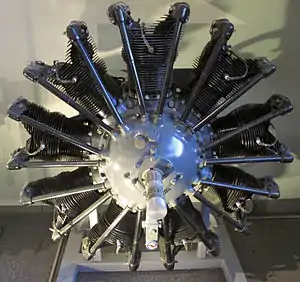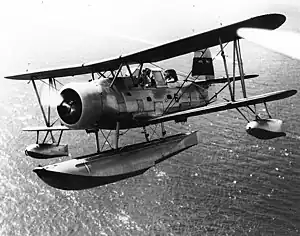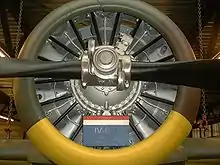Pratt & Whitney R-1340 Wasp
The Pratt & Whitney R-1340 Wasp is an aircraft engine of the reciprocating type that was widely used in American aircraft from the 1920s onward. It was the Pratt & Whitney aircraft company's first engine, and the first of the famed Wasp series. It was a single-row, nine-cylinder, air-cooled, radial design, and displaced 1,344 cubic inches (22 L); bore and stroke were both 5.75 in (146 mm). A total of 34,966 engines were produced.[1]
| R-1340 Wasp | |
|---|---|
 | |
| The first Pratt & Whitney Wasp | |
| Type | Radial engine |
| National origin | United States |
| Manufacturer | Pratt & Whitney |
| First run | 29 December 1925 |
| Major applications | Soko 522 Boeing P-26 Peashooter de Havilland Canada DHC-3 Otter North American T-6 Texan Sikorsky H-19 Junkers Ju 52 |
| Produced | 1926– |
| Number built | 34,966 |
| Developed into | Pratt & Whitney R-985 Wasp Junior |
As well as numerous types of fixed-wing aircraft, it was used to power helicopters, the Agusta-Bell AB.102 and the Sikorsky H-19, and a class of airship, the K-class blimp.
In 2016, it received designation as a Historic Engineering Landmark from the American Society of Mechanical Engineers.[2]
Variants
Note: R for Radial and 1340 for 1340 cubic inch displacement.
- R-1340-7
- 450 hp (340 kW), 600 hp (450 kW)
- R-1340-8
- 425 hp (317 kW)
- R-1340-9
- 450 hp (340 kW), 525 hp (391 kW)
- R-1340-16
- 550 hp (410 kW)
- R-1340-17
- 525 hp (391 kW)
- R-1340-19
- 600 hp (450 kW)
- R-1340-19F
- 600 hp (450 kW)
- R-1340-21G
- 550 hp (410 kW)
- R-1340-22
- 550 hp (410 kW)
- R-1340-23
- 575 hp (429 kW)
- R-1340-30
- 550 hp (410 kW)
- R-1340-31
- 550 hp (410 kW)
- R-1340-33
- 600 hp (450 kW)
- R-1340-48
- 600 hp (450 kW)
- R-1340-49
- 600 hp (450 kW)
- R-1340-AN1
- 550 hp (410 kW), 600 hp (450 kW)
- R-1340-AN2
- 550 hp (410 kW), 3:2 geared prop shaft
- R-1340-B
- 450 hp (340 kW)
- R-1340-D
- 500 hp (370 kW)
- R-1340-S1D1
- 525 hp (391 kW)
- R-1340-S1H1-G
- 550 hp (410 kW), 600 hp (450 kW)
- R-1340-S3H1
- 600 hp (450 kW)
- R-1340-T1D1
- 520 hp (390 kW)
Applications

- Agusta-Bell AB.102
- Air Tractor AT-301
- Air Tractor AT-401
- Ayres Thrush
- Bach Air Yacht
- Boeing Model 40A
- Boeing 247
- Boeing F3B
- Boeing F4B
- Boeing P-12
- Boeing P-26 Peashooter
- Boeing P-29
- CAC Ceres
- CAC Wirraway
- Curtiss Falcon
- Curtiss F7C Seahawk
- Curtiss O-52
- Curtiss P-6S Hawk
- Curtiss SOC Seagull
- de Havilland Canada DHC-3 Otter
- Douglas Dolphin
- Fairchild FB-3
- Fokker F.10
- Fokker F.32
- Ford Trimotor
- Gee Bee R-1
- Gee Bee R-2 Super Sportster
- Gee Bee R 1/2 Super Sportster
- Gee Bee YW
- Gee Bee Z
- Gee Bee QED
- Grumman Mallard
- Grumman Ag Cat
- Howard DGA-6
- Ireland N-2C Neptune
- Junkers W 34
- Junkers Ju 52
- Knoll Aircraft Company KN-3[3]
- Kaman HH-43 Huskie
- Lockheed Vega 5
- Lockheed Model 8 Sirius
- Lockheed Model 9 Orion
- Lockheed Model 10-C & 10-E Electra
- Lockheed XC-35
- Loening OL-8
- Noorduyn Norseman
- North American BC-1
- North American T-6/SNJ Texan/Harvard
- Northrop Alpha
- Northrop C-19 Alpha
- Scottish Aviation Twin Pioneer
- Sikorsky H-19
- Sikorsky S-38
- Soko 522
- TNCA MTW-1
- Thomas-Morse XP-13A Viper
- Vought O2U Corsair
- Wedell-Williams Model 45
- Westland Whirlwind (helicopter)
Engines on display
- There are a Wasp A and three Wasp C's on display at the New England Air Museum, Bradley International Airport, Windsor Locks, CT.[4][5][6][7]
Specifications (R-1340-S1H1-G)

Data from Jane's.[8]
General characteristics
- Type: Nine-cylinder single-row supercharged air-cooled radial engine
- Bore: 5.75 in (146 mm)
- Stroke: 5.75 in (146 mm)
- Displacement: 1,344 cu in (22.02 L)
- Length: 47.7 in (1,210 mm)
- Diameter: 51.75 in (1,314 mm)
- Dry weight: 930 lb (420 kg)
Components
- Valvetrain: Two overhead valves per cylinder
- Supercharger: Single-speed centrifugal type supercharger, 1:10 step-up
- Fuel system: Two-barrel Stromberg carburetor
- Fuel type: 91 octane rating gasoline
- Cooling system: Air-cooled
- Reduction gear: 3:2
Performance
- Power output: 600 hp (450 kW) at 2,250 rpm at 6,200 ft (1,900 m)
- Specific power: 0.45 hp/cu in (20.5 kW/L)
- Compression ratio: 6:1
- Power-to-weight ratio: 0.65 hp/lb (1.07 kW/kg)
See also
Related development
- Pratt & Whitney R-985 Wasp Junior
- Pratt & Whitney R-1535 Twin Wasp Junior
- Pratt & Whitney R-1830 Twin Wasp
Related lists
References
Notes
- Pratt&Whitney R-1340 page Retrieved: 25 October 2008
- "Pratt’s first engine gets historic designation" from Hartford Business Journal, published February 1st Retrieved: 7 April 2016
- "Knoll KN-3". Western Flying. August 1929.
- http://neam.org/index.php?option=com_content&view=article&layout=edit&id=1119 "Pratt & whitney R-1340 Wasp A"
- http://neam.org/index.php?option=com_content&view=article&layout=edit&id=1113 "Pratt & Whitney R-1340 Wasp C Cutaway"
- http://neam.org/index.php?option=com_content&view=article&layout=edit&id=1120 "Pratt & Whitney R-1340-0 Wasp C"
- http://neam.org/index.php?option=com_content&view=article&layout=edit&id=1122 "Pratt & Whitney Roscoe Turner R-1340 Wasp Engine"
- Bridgman 1994, p. 81d.
Bibliography
- Bridgman, Leonard. Jane's All the World's Aircraft 1945-46. Hammersmith, London: HarperCollinsPublishers (1994 reprint). ISBN 000 470831-8
- Gunston, Bill. World Encyclopedia of Aero Engines: From the Pioneers to the Present Day. 5th edition, Stroud, UK: Sutton, 2006.ISBN 0-7509-4479-X
- White, Graham. Allied Aircraft Piston Engines of World War II: History and Development of Frontline Aircraft Piston Engines Produced by Great Britain and the United States During World War II. Warrendale, Pennsylvania: SAE International, 1995. ISBN 1-56091-655-9
External links
- "Index of Wasp & R-1340 Designated Engines", a scanned Pratt & Whitney reference document from 1956 detailing the different Wasp versions, their specifications, and the aircraft they were installed in.
- "Radial Engines". Covington Aircraft. Retrieved October 26, 2019.
- There is a "Pratt & Whitney 1340N Radial Engine" in use on a T-6 Texan at Pacific Warbirds, Oahu, HI